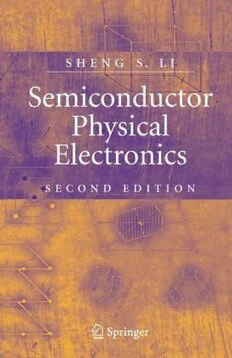
Semiconductor physical electronics PDF
Preview Semiconductor physical electronics
Semiconductor Physical Electronics Sheng S. Li Semiconductor Physical Electronics Second Edition With230Figures ShengS.Li DepartmentofElectricalandComputerEngineering UniversityofFlorida Gainesville,FL32611–6130 USA LibraryofCongressControlNumber:2005932828 ISBN10:0-387-28893-7 ISBN13:978-0387-28893-2 Printedonacid-freepaper. (cid:1)C 2006SpringerScience+BusinessMedia,LLC Allrightsreserved.Thisworkmaynotbetranslatedorcopiedinwholeorinpartwithoutthewritten permissionofthepublisher(SpringerScience+BusinessMedia,LLC,233SpringStreet,NewYork, NY10013,USA),exceptforbriefexcerptsinconnectionwithreviewsorscholarlyanalysis.Use in connection with any form of information storage and retrieval, electronic adaptation, computer software,orbysimilarordissimilarmethodologynowknownorhereafterdevelopedisforbidden. Theuseinthispublicationoftradenames,trademarks,servicemarks,andsimilarterms,evenifthey arenotidentifiedassuch,isnottobetakenasanexpressionofopinionastowhetherornottheyare subjecttoproprietaryrights. PrintedintheUnitedStatesofAmerica. (TB/EB) 9 8 7 6 5 4 3 2 1 springer.com Preface Thepurposeofthesecondeditionofthisbookistoupdatethedevelopmentsin varioussemiconductorandphotonicdevicessincethefirsteditionwaspublished in1993.Duetotheadvancesinsemiconductortechnologiesoverthepastdecade, manynewsemiconductordeviceshaveemergedandenteredthemarketplace.As a result, a significant portion of the material covered in the original book has been revised and updated. The intent of this book is to provide the reader with a self-contained treatment of the fundamental physics of semiconductor materi- als and devices. The author has used this book for a one-year graduate course sequence taught for many years in the Department of Electrical and Computer EngineeringoftheUniversityofFlorida.Itisintendedforfirst-yeargraduatestu- dentswhomajoredinelectricalengineering.However,manystudentsfromother disciplinesandbackgroundssuchaschemicalengineering,materialsscienceand engineering,andphysicshavealsotakenthiscoursesequence.Thisbookmayalso beusedasageneralreferenceforprocessinganddeviceengineersworkinginthe semiconductorindustry. Thepresentvolumecoversrelevanttopicsofbasicsolid-statephysicsandfun- damentals of semiconductor materials and devices and their applications. The mainsubjectscoveredincludecrystalstructures,latticedynamics,semiconductor statistics,one-electronenergybandtheory,excesscarrierphenomenaandrecom- binationmechanisms,carriertransportandscatteringmechanisms,opticalprop- erties,photoelectriceffects,metal–semiconductorcontactsanddevices,p-njunc- tiondiodes,bipolarjunctiontransistors(BJTs),heterojunctionbipolartransistors (HBTs),MOSdevices(MOSFETs,CCDs),photonicdevices(solarcells,LEDs, and LDs), quantum-effect devices (QWIPs, QDIPs, QW-LDs), and high-speed III-Vsemiconductordevices(MESFETs,HEMTs,HETs,RTDs,TEDs).Thetext presentsaunifiedandbalancedtreatmentofthephysicsofsemiconductormate- rialsanddevices.Itisintendedtoprovidephysicistsandmaterialsscientistswith more background on device applications, and device engineers with a broader knowledgeoffundamentalsemiconductorphysics. Thecontentsofthebookaredividedintotwoparts.InPartI(Chapters1–9),the subjects of fundamental solid-state and semiconductor physics that are essential forunderstandingthephysical,optical,andelectronicpropertiesofsemiconductor v vi Preface materials are presented. Part II (Chapters 10–16) deals with the basic device physics, device structures, operation principles, general characteristics, and ap- plicationsofvarioussemiconductorandphotonicdevices. Chapter1presentstheclassificationofsolids,crystalstructures,conceptofre- ciprocallatticeandBrillouinzone,Millerindices,crystalbindings,anddefectsin solids.Chapter2dealswiththethermalpropertiesandlatticedynamicsofcrys- tallinesolids.Thelattice-specificheat,thedispersionrelationoflatticevibrations, and the concept of phonons are also described. Chapter 3 is concerned with the three basic semiconductor statistics. Derivation of Maxwell–Boltzmann (M-B), Bose–Einstein (B-E), and Fermi–Dirac (F-D) distribution functions are given in this chapter. Chapter 4 describes the elements of quantum concepts and wave mechanics, the one-electron energy band theory, the effective mass concept for electronsandholesinasemiconductor,theenergybandstructuresforelemental andcompoundsemiconductors,andthedensity-of-statesfunctionsforbulksemi- conductorsandlow-dimensionalsystemssuchassuperlattices,quantumwells,and dots.Chapter5dealswiththeequilibriumpropertiesofintrinsicandextrinsicsemi- conductors.Derivationofgeneralexpressionsforelectronandholedensities,and discussionoftheshallow-anddeep-levelimpuritiesinsemiconductorsaregivenin thischapter.Chapter6presentstherecombinationmechanismsandexcesscarrier phenomenoninasemiconductor.Thebasicsemiconductorequations,whichgov- ernthetransportofexcesscarriersinasemiconductor,aredescribedinthischapter. Chapter7dealswiththederivationoftransportcoefficientsusingtheBoltzmann equationandrelaxationtimeapproximation.Thelow-fieldgalvanomagnetic,ther- moelectric, and thermomagnetic effects in n-type semiconductors are described in this chapter. Chapter 8 is concerned with the scattering mechanisms and the derivationofelectronmobilityinn-typesemiconductors.Therelaxationtimeand mobilityexpressionsfortheionizedandneutralimpurityscatteringsandacoustical andopticalphononscatteringsarederived.Chapter9presentstheopticalproperties andphotoelectriceffectsinsemiconductors.Thefundamentalopticalabsorption andfree-carrierabsorptionprocessesaswellasthephotoelectriceffectssuchas photoconductive,photovoltaic,andphotomagnetoelectriceffectsinasemiconduc- toraredepicted.Chapter10dealswiththebasictheoriesandrelevantelectronic properties of metal–semiconductor contacts and their applications. The current conductioninaSchottkybarrierdiode,methodsofdeterminingandenhancingthe barrierheightsinaSchottkycontact,andohmiccontactsinasemiconductorare presented.Chapter11presentsthebasicdevicetheoriesandcharacteristicsofap-n junctiondiode.Thep-nheterojunctiondiodesandjunction-fieldeffecttransistors (JFETs)arealsodiscussed.Chapter12isconcernedwiththedevicephysics,device structures, and characteristics of various photovoltaic devices (solar cells), pho- todetectors, and their applications. The solid-state light-emitting devices, which includethelight-emittingdiodes(LEDs)andsemiconductordiodelasers(LDs)are describedinChapter13.RecentadvancesinLEDsandLDsandtheirapplications aregiveninthischapter.Chapter14dealswiththebasicdevicephysics,modeling, andelectricalcharacteristicsofbipolarjunctiontransistors(BJTs),p-n-p-nfour- layer devices (SCRs, thyristers), and heterojunction bipolar transistors (HBTs). Preface vii Chapter 15 presents the silicon-based metal-oxide-semiconductor (MOS) de- vices.Thedevicephysicsandcharacteristicsforbothmetal-oxide-semiconductor field-effect transistors (MOSFETs) and charge-coupled devices (CCDs) are de- scribed. Finally, high-speed and high-frequency devices using GaAs and other III-V compound semiconductors are discussed in Chapter 16. The GaAs-based metal–semiconductorfield-effecttransistors(MESFETs),high-electron-mobility transistors (HEMTs), hot-electron transistors (HETs), resonant tunneling diodes (NTDs)andtransferredelectrondevices(TEDs)aredescribedinthischapter. Throughoutthetext,theauthorstressestheimportanceofbasicsemiconductor physicsanditsrelationtothepropertiesandperformanceofvarioussemiconductor devices. Without a good grasp of the physical concepts and a good understand- ingoftheunderlyingdevicephysics,itwouldbedifficulttotackletheproblems encountered in material growth, device processing and fabrication, device char- acterization, and modeling. The materials presented in this book should provide asolidfoundationforunderstandingthefundamentallimitationsofvarioussemi- conductormaterialsanddevices.Thisbookisespeciallyusefulforthosewhoare interested in strengthening and broadening their basic knowledge of solid-state andsemiconductordevicephysics. Theauthorwouldliketoacknowledgehiswife,“Julie”Wen-FuShih,forher support, love, and encouragement during the course of preparing this second edition. Contents Preface.................................................................................... v 1. ClassificationofSolidsandCrystalStructure................................. 1 1.1 Introduction.................................................................... 1 1.2 TheBravaisLattice........................................................... 2 1.3 TheCrystalStructure......................................................... 6 1.4 MillerIndicesandCrystalPlanes.......................................... 9 1.5 TheReciprocalLatticeandBrillouinZone............................... 11 1.6 TypesofCrystalBindings................................................... 14 1.7 DefectsinaCrystallineSolid............................................... 18 Problems........................................................................ 23 Bibliography................................................................... 24 2. LatticeDynamics................................................................... 26 2.1 Introduction.................................................................... 26 2.2 TheOne-DimensionalLinearChain....................................... 27 2.3 DispersionRelationforaThree-DimensionalLattice.................. 33 2.4 TheConceptofPhonons..................................................... 36 2.5 TheDensityofStatesandLatticeSpectrum............................. 37 2.6 LatticeSpecificHeat.......................................................... 39 Problems........................................................................ 42 References...................................................................... 44 Bibliography................................................................... 44 3. SemiconductorStatistics.......................................................... 45 3.1 Introduction.................................................................... 45 3.2 Maxwell–BoltzmannStatistics............................................. 46 3.3 Fermi–DiracStatistics........................................................ 50 3.4 Bose–EinsteinStatistics...................................................... 56 3.5 StatisticsfortheShallow-ImpurityStatesin aSemiconductor............................................................... 57 ix x Contents Problems........................................................................ 59 Bibliography................................................................... 60 4. EnergyBandTheory............................................................... 61 4.1 Introduction................................................................... 61 4.2 BasicQuantumConceptsandWaveMechanics....................... 62 4.3 TheBloch–FloquetTheorem.............................................. 66 4.4 TheKronig–PenneyModel................................................ 67 4.5 TheNearlyFreeElectronApproximation............................... 74 4.6 TheTight-BindingApproximation....................................... 80 4.7 EnergyBandStructuresforSomeSemiconductors................... 86 4.8 TheEffectiveMassConceptforElectronsandHoles................ 93 4.9 EnergyBandStructuresandDensityofStates forLow-DimensionalSystems............................................ 96 Problems....................................................................... 101 References.................................................................... 103 Bibliography.................................................................. 103 5. EquilibriumPropertiesofSemiconductors.................................... 105 5.1 Introduction................................................................... 105 5.2 DensitiesofElectronsandHolesinaSemiconductor................ 106 5.3 IntrinsicSemiconductors................................................... 113 5.4 ExtrinsicSemiconductors.................................................. 116 5.5 IonizationEnergiesofShallow-andDeep-LevelImpurities........ 123 5.6 HallEffect,ElectricalConductivity,andHallMobility ............. 125 5.7 HeavyDopingEffectsinaDegenerateSemiconductor.............. 128 Problems....................................................................... 130 References.................................................................... 132 Bibliography.................................................................. 133 6. ExcessCarrierPhenomenoninSemiconductors.............................. 134 6.1 Introduction................................................................... 134 6.2 NonradiativeRecombination:TheShockley–Read–HallModel... 135 6.3 Band-to-BandRadiativeRecombination................................ 140 6.4 Band-to-BandAugerRecombination.................................... 142 6.5 BasicSemiconductorEquations.......................................... 146 6.6 TheCharge-NeutralityEquation.......................................... 149 6.7 TheHaynes–ShockleyExperiment....................................... 151 6.8 ThePhotoconductivityDecayExperiment ............................. 154 6.9 SurfaceStatesandSurfaceRecombinationVelocity.................. 159 6.10 Deep-LevelTransientSpectroscopyTechnique........................ 162 6.11 SurfacePhotovoltageTechnique.......................................... 165 Problems....................................................................... 169 References.................................................................... 170 Bibliography.................................................................. 170 Contents xi 7. TransportPropertiesofSemiconductors...................................... 171 7.1 Introduction................................................................. 171 7.2 Galvanomagnetic,Thermoelectric,andThermomagnetic Effects........................................................................ 173 7.3 BoltzmannTransportEquation.......................................... 180 7.4 DerivationofTransportCoefficientsfor n-typeSemiconductors.................................................... 182 7.5 TransportCoefficientsfortheMixedConductionCase............. 195 7.6 TransportCoefficientsforSomeSemiconductors.................... 198 Problems..................................................................... 208 References................................................................... 209 Bibliography................................................................ 210 8. ScatteringMechanismsandCarrierMobilitiesinSemiconductors...... 211 8.1 Introduction................................................................. 211 8.2 DifferentialScatteringCross-Section.................................. 214 8.3 IonizedImpurityScattering.............................................. 217 8.4 NeutralImpurityScattering.............................................. 221 8.5 AcousticalPhononScattering............................................ 222 8.6 OpticalPhononScattering................................................ 228 8.7 ScatteringbyDislocations................................................ 230 8.8 ElectronandHoleMobilitiesinSemiconductors.................... 231 8.9 Hot-ElectronEffectsinaSemiconductor.............................. 239 Problems..................................................................... 243 References................................................................... 244 Bibliography................................................................ 244 9. OpticalPropertiesandPhotoelectricEffects................................. 246 9.1 Introduction................................................................. 246 9.2 OpticalConstantsofaSolid.............................................. 247 9.3 Free-CarrierAbsorptionProcess........................................ 252 9.4 FundamentalAbsorptionProcess....................................... 256 9.5 ThePhotoconductivityEffect............................................ 264 9.6 ThePhotovoltaic(Dember)Effect...................................... 275 9.7 ThePhotomagnetoelectricEffect........................................ 277 Problems..................................................................... 281 References................................................................... 283 Bibliography................................................................ 283 10. Metal–SemiconductorContacts................................................ 284 10.1 Introduction................................................................. 284 10.2 MetalWorkFunctionandSchottkyEffect............................ 285 10.3 ThermionicEmissionTheory............................................ 288 10.4 IdealSchottkyContact.................................................... 290 10.5 CurrentFlowinaSchottkyDiode...................................... 295
